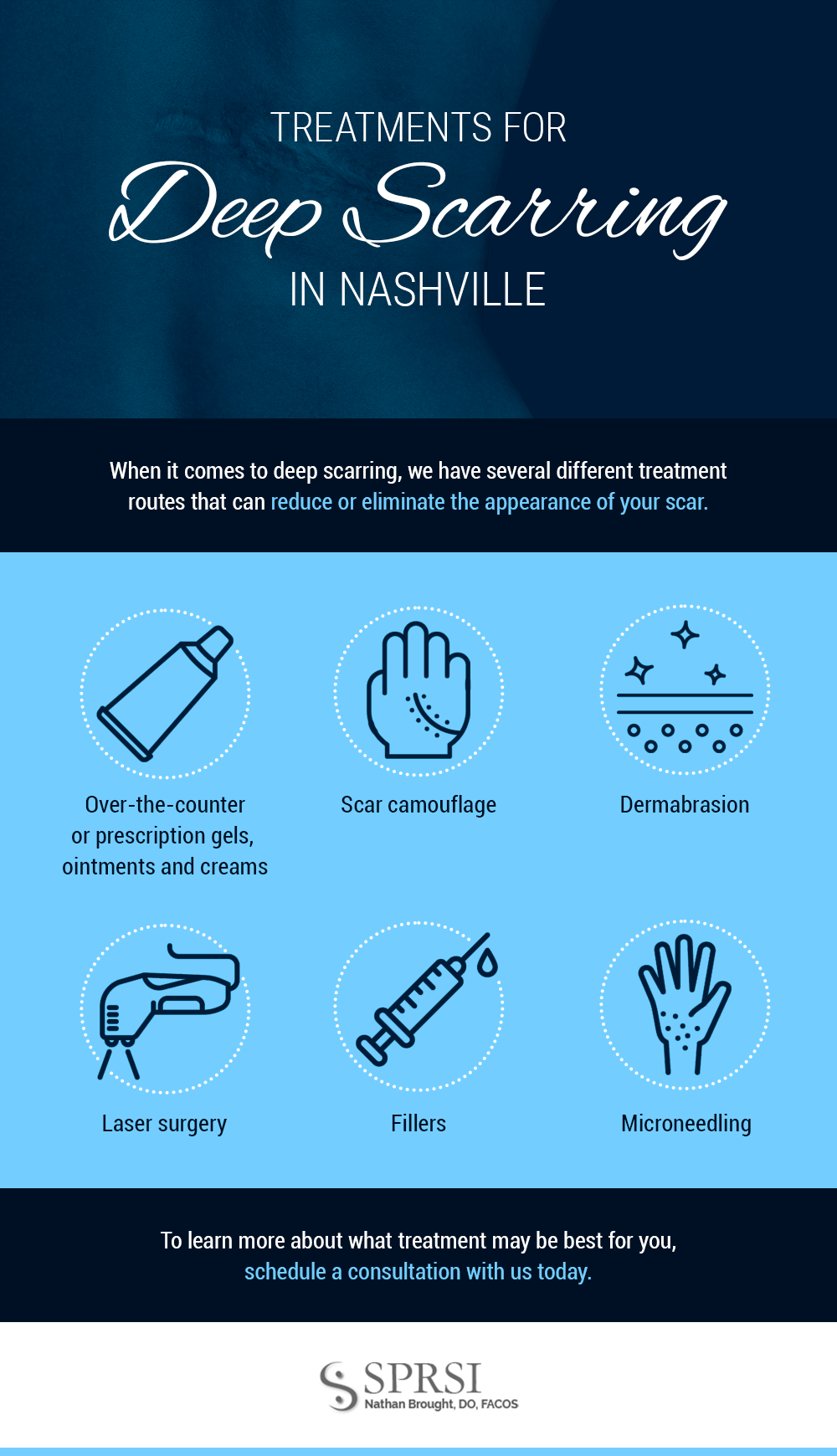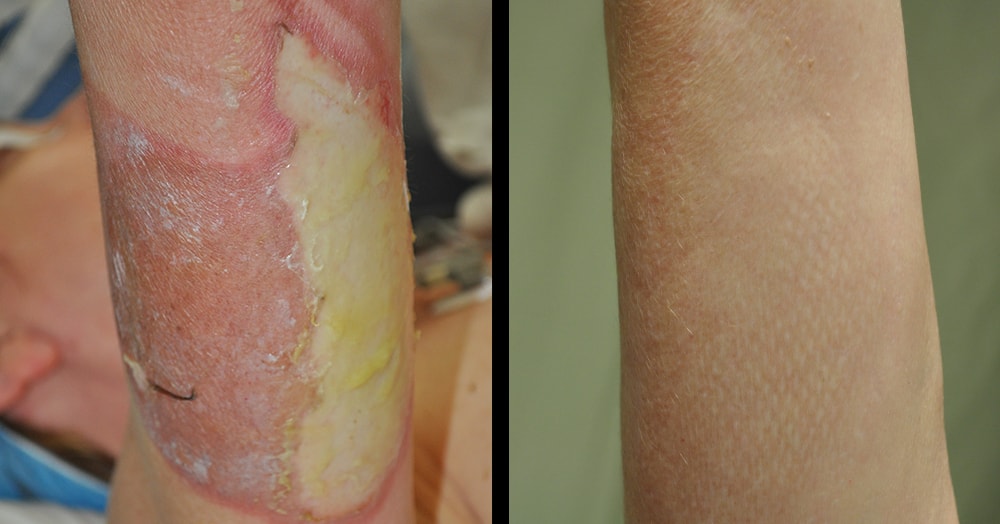Scar Treatment Services in Franklin & Nashville TN

Did you know that skin is your largest organ? Not only is your skin your first line of defense against injury, but it also tells the world about your health and well being. For many people, protecting it from damage and injury is a top priority -but even the most cautious individuals can sustain serious damage that can result in scarring.
Scars change the appearance of the skin but can also cause emotional discomfort. If you have a scar that you would like removed so you can feel more youthful and confident, Dr. Nathan Brought and the staff members at the Southern Plastic & Reconstructive Surgical Institute can help.
Schedule A Scar Treatment Consultation TodayHow Scarring Occurs
Although you may see a scar as evidence of injury or damage, it’s actually the body’s attempt to heal itself. Its size, shape and color depend on a diverse range of factors. In general, the more severe the injury, the worse the scar. For instance, a burn scar is quite different in appearance than a common laceration. Everything from age to gender to ethnicity can affect the appearance and treatment of a scar.
Surface Scars
Surface scars form for different reasons, but they generally only affect the visible surface of the skin. Here are some types of surface scars:
- Keloid scars are those which extend outside the borders of the original insult or injury, and they typically result from over-compensated healing. In certain locations, keloid scars can affect movement. These are most common in clients with darker skin pigments.
- Hypertrophic scars are scars which are increased in size/thickened but remain within the borders of the insult or injury. At SPRSI, we may be able to remove a hypertrophic scar surgically, or reduce its size with certain treatments such as steroid injections. Common treatments for keloid and hypertrophic scars also include laser therapy and silicone sheets.
- Hyper-pigmentation usually appears as a dark or red area on the skin. It can be caused by contact with chemical irritants as well as with extremely cold or hot surfaces. These are relatively minor scars that affect the surface of the skin, but they can be unsightly depending on where they are located.
- Hypo-pigmentation scars look like small white lines on the the surface of the skin. The small areas of scar tissue do not develop a normal skin color but instead remain white, making them highly visible, especially on darker skin tones.
Although they are only on the surface of the skin, some of these types of scars are difficult to remove, especially if they are old scars.

Deep Scars
Scars that run deep may look smaller than surface scars, but the damage is more significant. Sometimes the cause of the scar is a better indicator of the amount of possible damage than the visibility of it is:
- Contracture scars can indicate damage deep in the tissue. Burning typically causes a contracture scar that may negatively affect your ability to move. Contracture scars often run deep into the skin, and may even affect tissues underneath, such as nerves and muscles. They typically tighten skin.
- Atrophic scars look like a depression or hole in the skin where there is actually a missing layer of skin. Atrophic scarring is usually caused by a skin disease like acne or chicken pox. Deep pits and wavelike scars are common. How these scars are treated depends on the size and severity of the damage.
- Ice pick scars are small, deep holes in the skin that look like they were poked by an ice pick. This type of scarring is common from acne where the infection and inflammation destroyed the skin below the surface.
- Boxcar scars can also form as a result of an acne outbreak. These larger, crater-shaped scars are also the result of missing tissue below the surface and can be formed when two pimples join together below the surface and hollow out a contiguous area.
Dr. Brought can tell a lot about the cause of a scar just by looking at it. Once the injury or disease is over, however, and the body has completed its healing process, it is time for us to reduce the appearance of that scar to improve your overall look.
Treatments for Deep Scarring in Nashville
In some cases, Dr. Brought may be able to recommend a topical solution to reduce or eliminate the appearance of your scar. Gels, ointments and creams are available on an over-the-counter and prescription basis. Topical treatments are generally good for discoloration scars or to reduce the appearance of a scar that is still developing.
There are other options as well – dermabrasion, laser surgery and even popular skin fillers may be used to improve the appearance of certain scars:
- Scar Camouflage Scar camouflage infuses your scar with skin toned color to make it blend with the skin around it. It is a medical tattoo process that injects color just under the skin. When your scar is the right color, it will be barely noticeable.
- Dermabrasion can be used to reduce the appearance of surface scars, or it can be combined with other techniques to treat more complicated scars. As the term suggests, dermabrasion is a way of rubbing off the surface skin cells to reveal new cells underneath. Dermabrasion also stimulates the growth of new cells at the surface.
- Laser surgery accomplishes the same affect as dermabrasion by using a laser to remove surface skin cells. The laser can target specific areas of skin with great precision, leaving healthy cells untouched.
- Fillers work especially well on boxcar scars and other skin depressions. A natural substance or one synthesized to stimulate collagen production is injected into the scar. The filler actually fills in the depression to give your skin a smoother look.
- Microneedling is a technique that stimulates collagen production to improve the appearance of skin. It can be used around surface scars or as a finishing treatment for deeper scars. The technique involves using a special tool that pokes the skin with a tiny needle. The exact depth of the needle insertions and spacing between them in controlled to achieve the desired outcome.
To learn about the treatment that’s best for you, contact us today to schedule a consultation with Dr. Brought.
Nathan Brought, DO

Nashville plastic surgeon Dr. Nathan Brought provides outstanding patient care using a holistic approach to treatment. He's a member of the American College of Osteopathic Surgeons, the American Osteopath Association, the Tennessee Society of Plastic and Reconstructive Surgeons and the Tennessee Osteopathic Medical Association. Dr. Brought graduated from Dickinson College and the Lake Eric College of Osteopathic Medicine, and completed his residency with the Pinnacle Health System in Harrisburg, PA.
Information on Other Skin Procedures



